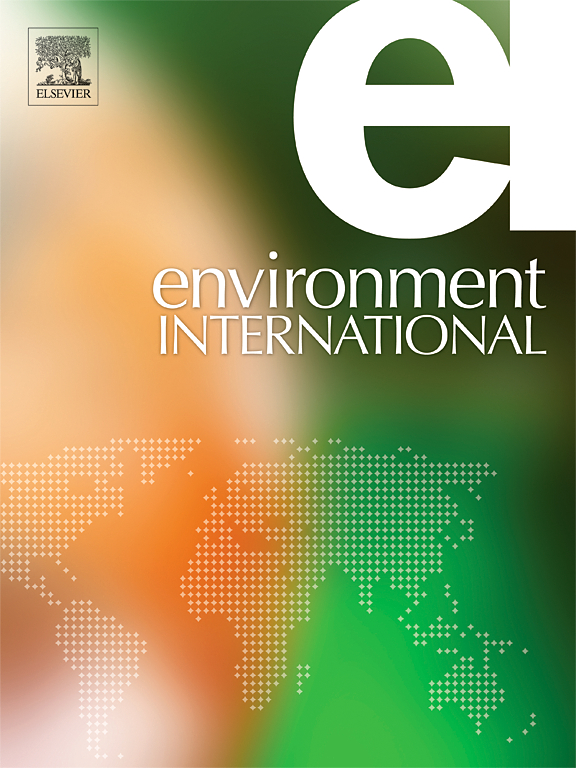气候变化和人口情景下拉丁美洲城市未来与温度相关的死亡率
IF 10.3
1区 环境科学与生态学
Q1 ENVIRONMENTAL SCIENCES
引用次数: 0
摘要
在拉丁美洲,气候变化、城市化和人口老龄化加剧了极端温度带来的健康风险。为了准确评估未来与温度相关的死亡率影响,整合关键人口因素的证据——如人口年龄构成、死亡率和人口规模的动态——是必不可少的。方法我们预测了非最佳温度对2045-2054年间拉丁美洲326个城市的全年龄和年龄特异性死亡率的影响。我们的分析结合了城市级别的每日死亡率计数、网格化温度数据、缩小和修正偏差的温度模拟以及人口统计数据。我们预测了两种气候变化情景下温度-死亡率的影响,同时也考虑了人口规模、年龄结构和年龄特异性死亡率的变化。到2045年至2054年,在最极端温度情景下,热致死亡的百分比将从0.87%增加一倍以上(95% CI 0.77;0.96)至2.06% (95% CI 1.80;2.33),但与感冒有关的死亡率会下降。人口增长和老龄化将加剧与热有关的风险,抵消与冷有关的死亡减少。例如,在中等温度情景下,人口年龄结构的变化将导致与热有关的死亡率比基线增加176%。除了温度变化之外,人口变化——特别是人口增长和老龄化——将显著放大本世纪中叶温度对死亡率的影响,强调有针对性的气候适应和公共卫生战略的必要性。本文章由计算机程序翻译,如有差异,请以英文原文为准。

Future temperature-related mortality in Latin American cities under climate change and population scenarios
Background
In Latin America, climate change, urbanization, and an aging population are intensifying health risks from extreme temperatures. To accurately assess future temperature-related mortality impacts, evidence that integrates key demographic factors—such as the dynamics of population age composition, mortality rates, and population size—is essential.Methods
We projected the impact of nonoptimal temperatures on all-age and age-specific mortality during 2045–2054 for 326 cities in Latin America. Our analysis combined city-level daily mortality counts, gridded temperature data, downscaled and bias-corrected temperature simulations, and demographic data. We projected temperature-mortality impacts under two climate change scenarios while also considering changing population size, age structure, and age-specific mortality rates.Findings
By 2045–2054, the percentage of heat-attributable deaths under the most extreme temperature scenario will more than double from 0.87 % (95 % CI 0.77; 0.96) to 2.06 % (95% CI 1.80; 2.33), but cold-related mortality will decrease. Population growth and aging will exacerbate heat-related risks and offset reductions in cold-related deaths. For example, changes in population age structure will drive an increase in the heat-related mortality rate of 176% from baseline for a moderate temperature scenario.Interpretation
Beyond temperature changes, demographic shifts—particularly population growth and aging—will significantly amplify mid-century temperature impacts on mortality, underscoring the need for targeted climate adaptation and public health strategies.求助全文
通过发布文献求助,成功后即可免费获取论文全文。
去求助
来源期刊

Environment International
环境科学-环境科学
CiteScore
21.90
自引率
3.40%
发文量
734
审稿时长
2.8 months
期刊介绍:
Environmental Health publishes manuscripts focusing on critical aspects of environmental and occupational medicine, including studies in toxicology and epidemiology, to illuminate the human health implications of exposure to environmental hazards. The journal adopts an open-access model and practices open peer review.
It caters to scientists and practitioners across all environmental science domains, directly or indirectly impacting human health and well-being. With a commitment to enhancing the prevention of environmentally-related health risks, Environmental Health serves as a public health journal for the community and scientists engaged in matters of public health significance concerning the environment.
 求助内容:
求助内容: 应助结果提醒方式:
应助结果提醒方式:


